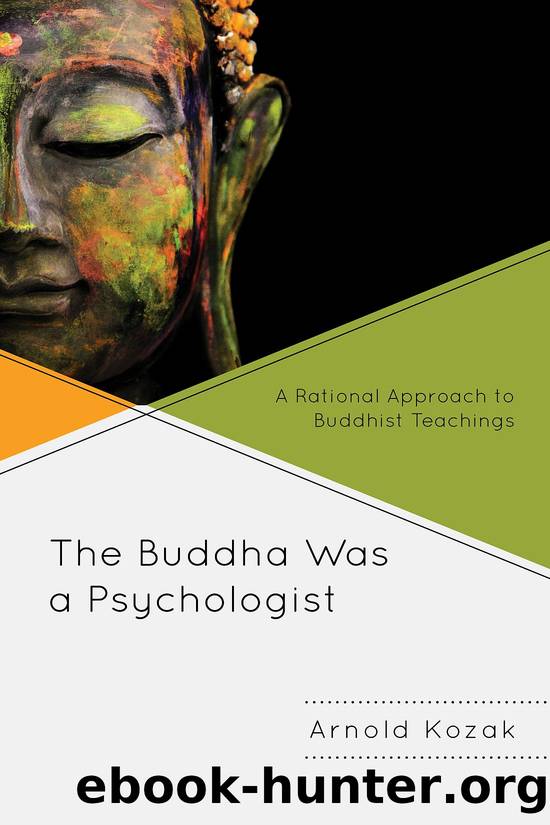The Buddha Was a Psychologist by Arnold Kozak

Author:Arnold Kozak
Language: eng
Format: epub
Publisher: LEXINGTON BOOKS
Chapter 6
The Fourth Ennobling Praxis
Resolving the Problem
The Buddha declared his fourth proposition: âThe Truth of the Path: This, O Monks, is the Truth of the Path (Magga) which leads to the cessation of suffering. It is this Noble Eightfold Path, which consists of (1) Right View, (2) Right Resolve, (3) Right Speech, (4), Right Action, (5) Right Livelihood, (6) Right Effort, (7) Right Mindfulness, (8) Right Meditationâ (Keown 1996, 54).
For our patient to be cured, she must follow a treatment plan; she must take her medicine as prescribed. This therapeutic is provided by the fourth ennobling praxis: âThe Eightfold1 Path is thus a path of self-transformation: an intellectual, emotional, and moral restructuring in which a person is reoriented from selfish, limited objectives towards a horizon of possibilities and opportunities for fulfillmentâ (Keown 1996, 56). Three categories comprise the path: wisdom (prajna), morality/ethics (sila), and meditation (samahdi). Each category supports and is necessary for the other like a three-legged stool. The Eightfold Path can be viewed synergistically with each component interacting with every other; they are not discreet and independent (Batchelor 2015).
The eight items of the fourth ennobling praxis are all preceded with the term sammaâtraditionally translated as âright.â Analayo (2018a) suggests that âtoward one pointâ or âconnected in oneâ might be more accurate translations. âTrueâ can also work in the sense that a wheel that is true is not bent, which works nicely with the broken axle or bad wheel of the Buddhaâs dukkha metaphor. While preferable to âright,â âtrueâ has epistemological connotations that might be distracting. Batchelor translates samma as âcomplete,â which has fewer moral implications. The Pali Text Societyâs Pali-English dictionary defines samma as âharmony or completeness.â Sammata, which is derived from samma, can refer to âcorrectnessâ or ârightness.â This is, perhaps, the source of the confusion. Whatever the preferred term, each of these eight elements requires mastery. Perhaps, then, âintegralâ might be preferable since ârightâ connotes right and wrong, whereas integral has a more pragmatic feel. Similarly, I prefer a sense of âwholeheartednessâ toward each of them, which seems consistent with Batchelorâs âcomplete.â
For the Buddha, there was skillfulness or unskillfulness and instances of the latter were occasions for self-improvement rather than condemnation: âFor he who acknowledges his transgression as such and confesses it for the betterment in the future will grow in the noble (ariyan) disciplineâ (Batchelor 2015, 227). The response to unskillfulness is not shaming oneself, penitence, or other deprivation but, rather, learning, accommodation, and betterment in the context of commitment to the path.
In short, 1) wisdom entails understanding the three marks of existenceâdukkha, impermanence, and not self (view) and 2) a commitment to working on integrating that intellectual understanding so that it is experiential (resolve). To be resolved requires not only cultivating clear understanding of how things works but dedicating oneself to behaving in a conducive manner (speech, action, livelihood) and devoting some of those behaviors to systematic and disciplined introspective study of oneself (effort, mindfulness, concentration). Wisdom facilitates ethics because one knows that acting unskillfully is futile.
Download
This site does not store any files on its server. We only index and link to content provided by other sites. Please contact the content providers to delete copyright contents if any and email us, we'll remove relevant links or contents immediately.
| Administration & Medicine Economics | Allied Health Professions |
| Basic Sciences | Dentistry |
| History | Medical Informatics |
| Medicine | Nursing |
| Pharmacology | Psychology |
| Research | Veterinary Medicine |
Bioenergetica by Alexander Lowen(1424)
The Child in You by Stefanie Stahl(1200)
No Bad Parts by Richard C. Schwartz(1170)
Noise: A Flaw in Human Judgment by Sunstein Cass R. & Sibony Olivier & Kahneman Daniel(1153)
The Data Detective by Tim Harford(1099)
Chatter by Ethan Kross(1022)
The Science of Rapid Skill Acquisition by Peter Hollins(870)
The Quantum Psychiatrist: From Zero to Zen Using Evidence-Based Solutions Beyond Medication and Therapy by Biswas Dona(832)
Freedom by Sebastian Junger(813)
The Montessori Baby by Simone Davies(787)
Maps of Meaning: The Architecture of Belief by Jordan B. Peterson(705)
The Science of Self-Learning: How to Teach Yourself Anything, Learn More in Less Time, and Direct Your Own Education (Learning how to Learn Book 1) by Peter Hollins(689)
Evolution Gone Wrong: The Curious Reasons Why Our Bodies Work by Alex Bezzerides(672)
Sadomasochism and the BDSM Community in the United States by Stephen K. Stein(651)
Anxiety For Dummies by Charles H. Elliott & Laura L. Smith(634)
Why Sex Doesn't Matter by Olivia Fane(627)
Disconnected by thomas Kersting(620)
Jung - The Key Ideas: Teach Yourself (TY Philosophy) by Ruth Snowden(593)
The Mechanics of Passions: Brain, Behaviour, and Society by Alain Ehrenberg(590)
